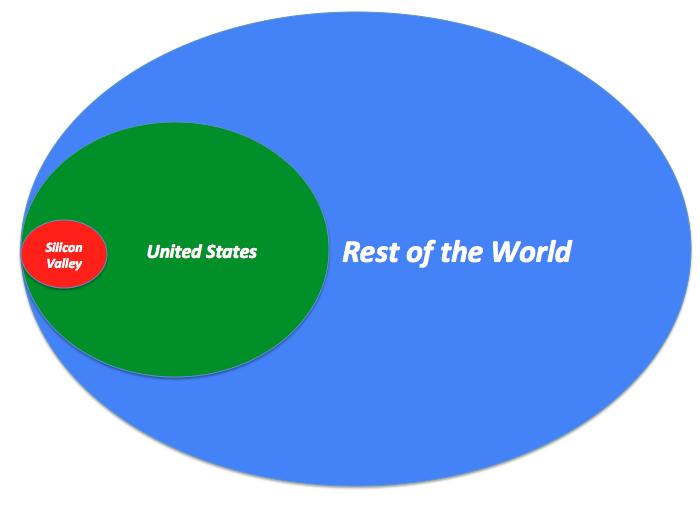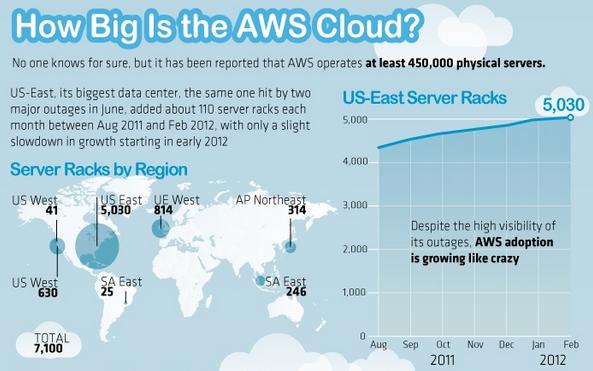Cloud and the Three IT Geographies (Silicon Valley, US and Rest of the World)
In the last 3 years I spent most of my time advocating that the cloud world is marching at a (very) different pace based on where you are and who you are.
If you are a professor consultant working with the like of Google, Facebook and such your vision of the world may be a bit skewed compared to "the average". I am sorry if I shocked you.
Similarly, if you consult for a big manufacturing company in Italy you may be skewed as well (but in a different way and for different reasons).
The former consultant may be bored about promoting Amazon as "the next big thing" and may already be looking for "what's coming next". The latter may think that the coolest thing on earth is the next version of the AS/400. I am sure you appreciate the 20 years disconnect between the two.
Back in January I visited Palo Alto and I was out for dinner with Mathew Lodge and James Watters when I remember telling them that "this [Silicon Valley] is not the real world". From there I started building my theory that, in IT and specifically with "cloud" (whatever that means), there are really three geographies in the world and they don't map to the traditional Americas, EMEA and APAC.
They are instead: "The Valley", "US" and "the Rest of the World". Graphically this means:

Note: I had to hurry up writing this post (that I had drafted a long time ago) because Rodrigo was starting to use the same parlance with his Silicon Valley PaaS and I didn't want to be left behind. Mark Thiele also has a good piece on this subject.
If you think this may be a joke I think one good metric to measure the level of innovation in the world is to show where cloud is actually being used (rather than being talked). So I am going to use an infographic where the AWS resources distribution are nicely summarized:

Now, regardless how big AWS is in absolute terms, it's interesting to notice the distribution of its racks across the globe. Quick (rounded) math shows:
US: (5030 + 41 + 630) / 7100 = roughly 80%
EMEA: 814 / 7100 = roughly 11%
APAC: (314 + 246) / 7100 = roughly 8%
(South America would account for the remaining rounded 1%... never mind, it's irrelevant).
Now one would need to cross data between # of businesses across the world, their revenues, how much they spend in IT and the distribution of the servers in the infographic above. I am not going to do such a detail analysis. It is however pretty clear that the world is marching at a very different innovation pace. If you discount exceptions like (perhaps) London or Singapore, the US is leading at a speed that seems to be roughly 8x that of the other two geographies (i.e. the generic rest of the world).
Why is that? One can only speculate but wouldn't fall far from truth: innovative culture, inertia, money, country laws and regulations. You name them.
Virtualization was an easy play for everyone. There wasn't a real change to the IT processes: a sysadmin used to deploy a physical box, now he/she can deploy a virtual machine instead. It changed the world but no big deal per se. Totally transparent to everyone except the sysadmin. Also the decision to go down this path was typically ROI based (and with virtualization you'd typically have a very tangible short term ROI).
With cloud everything changes. Things like self-service expose the change to a much wider audience other than the sysadmin. Also, going down the cloud path isn't anymore a "cost reduction" thing but rather a "business alignment thing". Especially in a tough economy, many are ready to spend money to "save money" (ROI)... but you really need to be bought into something (or very enlightened) before spending money to be "more agile"...
Not to mention the public cloud dimension (which is what Amazon is all about) Vs. the more traditional way of running workloads inside the datacenter. Do we want to talk about that?
Long story short, the US are just much better prepared (IMO at least) to a change like this and have a much more innovative attitude compared to the rest of the world (on average at least).
In my new "IT Geographies layout" I however specifically call out Silicon Valley. Not because of the number of particularly innovative deployments (after all the area is full of very innovative vendors rather than buyers) but to make the point that there the pace of the cloud innovation march is just insane. There is where most of the IT professors consultants and vendors keep arguing that "if you don't design your data centers like Google you are a dumb".
My dear friends in the rest of the world... fear not, they don't know what the real world looks like. They don't understand what's happening on this planet, they live in their little IT paradise.. In particular:
-
They have no clue that, in the rest of the world, big insurance companies are still using the Novell client on their 5 years old Windows PCs (true story, worth mentioning that not only the product doesn't exist anymore, but the vendor as a whole went belly up).
-
They have no clue that, in the rest of the world, big banks are building clouds (or so they call them) because their CEO went to an event where they said cloud was the way to go.. but no one had an idea what it is (true story, classic).
-
They have no clue that, in the rest of the world, in (other) big banks developers would bring ESXi servers to put under their desks because they think Amazon only sells books (true story, albeit I can only speculate on why they would bring a server from home!).
-
They have no clue that, in the rest of the world, databases are pretty much all protected by boring OS level failover clusters (mostly on Unix) and not by some fancy distributed database technology (true story, albeit I am sure all will get there sooner or later)
-
They have no clue that, in the rest of the world, a big telco hires a string of consultants for "overnight P2V activities" of their legacy Windows servers (true story, a moment of silence for these consultants please)
I could go on and on with these (true) nuggets of real world experience but I think you get the point. I am wondering how much of this is true in the US (I am sure not every company there is a zero-legacy organization albeit the attitude is much better).
I am sorry but it makes me smile when I hear "oh that is not cloud, that is virtualization 2.0". Really? For many, even virtualization 2.0 is very much going to be a 2018 project! Look, seriously, I am convinced that what you are pitching is where we are going. I am totally bought. You just need to accept the fact that what's been thought in Silicon Valley in 2010 is probably going to go mainstream on the planet around 2015-2020.
I always advise my HQ that we clearly need to be ahead of the curve of what's going but in doing so we can't afford to have our customers lose sight of us if we accelerate too much. Being too ahead of your time is as much of a failure as being too behind of your times.
By the way, I want to share something with the professors consultants that keep mentioning the war is over and that Amazon is a 1B$ cloud business. I have a tremendous respect for Amazon and for what they are doing and they are obviously extremely well positioned in this battle... but, just for your information and as a reminder, 1B$ is (more or less) what IBM still makes out of the AS/400 line of business (talking about history). Welcome to the real world folks.
No, I am sorry, with all respect for Amazon, this battle has just begun IMO.
Massimo.
UPDATE (Sept 6th): There have been some comments below and on Twitter that give me the impression my segmentation was misunderstood. I just want to make clear that Silicon Valley, in the context of this post, is a state of mind and not (just) a physical location. Certainly it’s not a place where the deployments are. My only point in this post was that that there is an innovation theory (Silicon Valley) and then there are two “execution realities” (US and rest of the world). Silicon Valley is years ahead compared to the US execution ability as a whole. And the US execution ability is years ahead of the rest of the world execution ability.